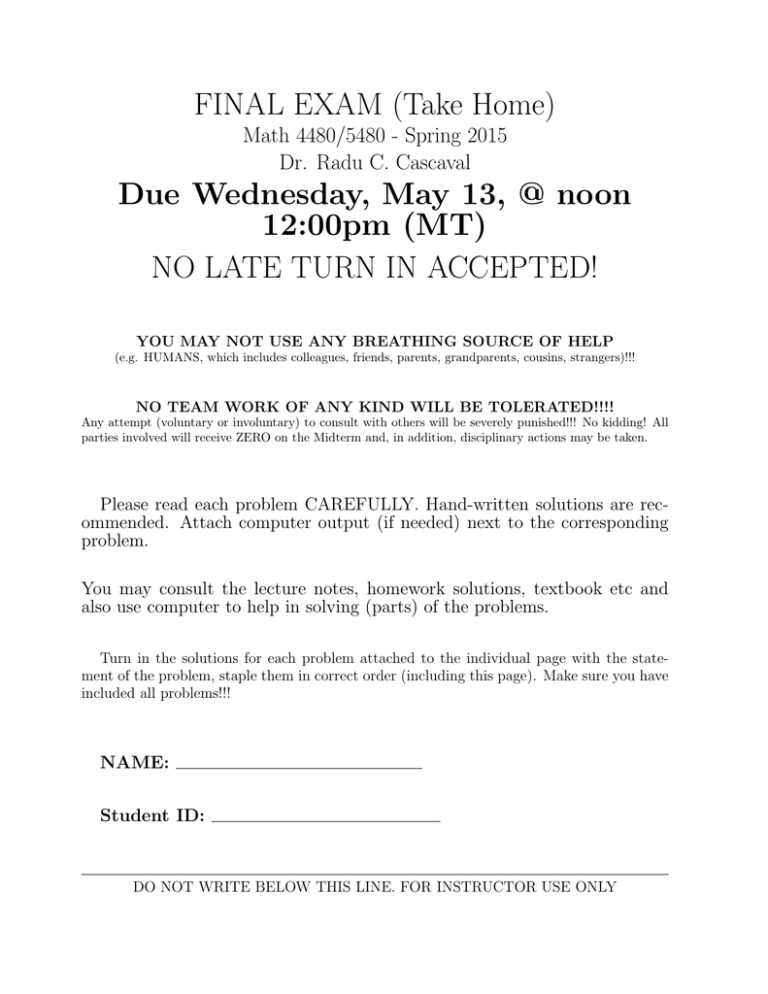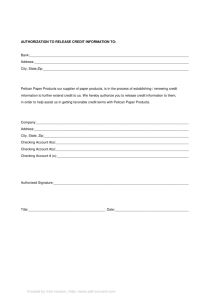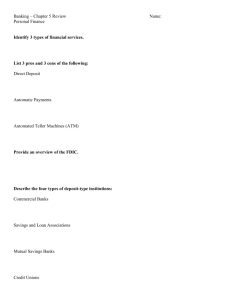FINAL EXAM (Take Home) Due Wednesday, May 13, @ noon 12:00pm (MT)
advertisement

FINAL EXAM (Take Home) Math 4480/5480 - Spring 2015 Dr. Radu C. Cascaval Due Wednesday, May 13, @ noon 12:00pm (MT) NO LATE TURN IN ACCEPTED! YOU MAY NOT USE ANY BREATHING SOURCE OF HELP (e.g. HUMANS, which includes colleagues, friends, parents, grandparents, cousins, strangers)!!! NO TEAM WORK OF ANY KIND WILL BE TOLERATED!!!! Any attempt (voluntary or involuntary) to consult with others will be severely punished!!! No kidding! All parties involved will receive ZERO on the Midterm and, in addition, disciplinary actions may be taken. Please read each problem CAREFULLY. Hand-written solutions are recommended. Attach computer output (if needed) next to the corresponding problem. You may consult the lecture notes, homework solutions, textbook etc and also use computer to help in solving (parts) of the problems. Turn in the solutions for each problem attached to the individual page with the statement of the problem, staple them in correct order (including this page). Make sure you have included all problems!!! NAME: Student ID: DO NOT WRITE BELOW THIS LINE. FOR INSTRUCTOR USE ONLY 1. FIXED INTEREST REINVESTMENT (DISCRETE MODEL) Bank ”X” offers you to open fee-free savings and checking accounts for a period of T = 10 years. The savings account has r = 5% annual interest rate, while the checking account has zero (nada!) interest rate. Money in the savings account cannot be withdrawn (as a bulk sum) during the entire period T = 10 years, but the account rules allow for a fraction of the interest accrued at any given time to be moved to the checking account. Money in the checking account can be accessed at any time, so you can spend it as you wish, or leave it to accumulate. You decide to deposit an initial amount x0 = $10, 000 in the savings account, but want to maximize the return, measured by the total amount moved into the checking account throughout the entire period (and available for spending) Assume that the interest is compounded n times a year (say, quarterly n = 4) and that you decide on a fixed fraction u of the interest accrued during each quarter to be reinvested (left in the savings account) ( 0 ≤ u ≤ 1.) Let xk be the amount of money in the savings account at the end of the k th quarter. The discrete dynamical system that describes how money grows in the savings account is r xk+1 = xk + uxk , k = 0, . . . , N − 1 (1) n (N is the number of times interest is computed during the entire period, N = nT ). (a) Express xk as a function of the initial deposit x0 . (b) Find an expression (as a function of u) for the total amount accumulated in the checking account throughout the entire period (assuming none was spent). [Use the N −1 identity 1 + α + α2 + . . . + αN −1 = αα−1 , if α 6= 1.] (c) What value of the fixed fraction u ∈ [0, 1] maximizes the total amount of money accumulated in the checking account throughout the period (found in part (b)). 2. OPTIMAL INTEREST REINVESTMENT (CONTINUOUS MODEL) Same scenario as the previous problem, but now assume interest in the savings account is compounded continuously and that you are allowed to choose a variable fraction of the interest (continuously) reinvested in the savings account u = u(t) at any time t. Let x(t) be the amount of money present in the savings account at time t. Let u = u(t) (where 0 ≤ u ≤ 1) denote the fraction of the interest accrued at time t which stays in the savings account. Then 1 − u(t) represents the fraction of the interest which is moved to the checking account at time t. The interest reinvestment in this case leads to the continuous dynamical system (can you explain why?) x0 (t) = ru(t)x(t), t ∈ [0, T ]. (2) The problem is to choose u(t) so as to maximize the total money accumulated (or available for spending) from the checking account during the entire period of time T > 0: Z T r(1 − u(t))x(t)dt maximize J(u) = 0 [Hint: Use the bang-bang control u(t) = 0or1 for portions of the interval [0, T ].] (3) 3. POPULATION TESTING Imagine an outbreak of a potentially lethal virus has just occurred and that we need to test every single person in the population, with either positive or negative results. Suppose that one can take specimens from several persons and test the combined specimen as a unit, such as may be the case in certain types of blood tests. Assume that the combined specimen will give a negative result if and only if all contributing specimens are negative. Thus, in the case of a positive result (of the combined specimen), all specimens must be retested individually to determine which are positive. If N is the total population and is divided into groups of n persons (hence k = N/n groups), then the following choices arise (the cost of testing one specimen or group of specimens is the same): (I) Test all N persons individually, requiring N tests. (II) Test groups of n > 1 specimens, which may require as few as k = N/n or as many as (n + 1)k = N + k tests. We assume the probability of a person being infected is p, the same for all persons and that infections cannot occur at a later time. Also, test outcomes for person within the same group tested are independent. Let X be the number of tests required to cover the entire population for all N persons, and let Xi be the number of tests required for testing the persons in the ith group, i = 1, ...k. (a) Determine the expected number, E[X], of tests required under (II) (as a function of n). (b) What value of n minimizes E[X], the expected number of tests needed. (c) Determine the range of values for p for which the optimal E[X] found in part (b) is less than N (that is it makes sense to do group testing rather than individual testing) (d) If N = 5000 and p = 0.3, what is the optimal n which minimizes E[X] and what is this minimum value? 4. TEMPERATURE DISTRIBUTION Consider the following Markov chain model for the evolution of temperature in a straight metal rod. Positions 1 through N are equally spaced along the rod. 1 − 2 − . . . − (N − 1) − N Transitions from state k to state k have probability 1 − p where 0 < p < 1. Transitions to the right or left are equally likely, except at position 1 where transitions to the left have probability 0, and at position N , where transitions to the right have probability 0. (a) Draw a state transition diagram, complete with probabilities. (b) Find the transition matrix for this Markov Chain. (c) Does the theory of Markov chains predict convergence to a limiting probability vector in this case? If not, why? If yes, find the stable equilibrium vector. [You may answer this by doing simulations with various values of N and p]







